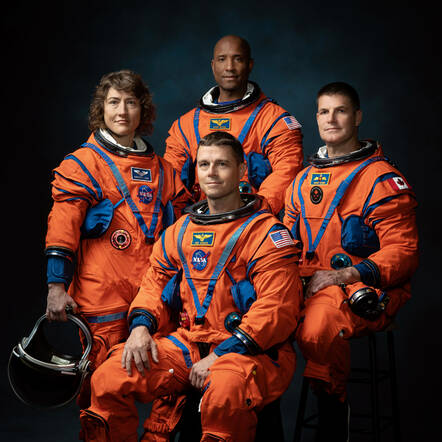This article is more than 1 year old
NASA names astronauts picked for next Artemis Moon test flight
First for women, people of color, Canucks
NASA today named the Artemis Moon program's first crew of astronauts. Among them are the first woman, the first person of color, and the first Canadian set to blast off on a lunar mission
Their mission, dubbed Artemis II, will be to perform a test flight assessing not only the space agency's most powerful rocket, the Space Launch System (SLS), but also the attached capsule, Orion, which will eventually be used to ferry people to the Moon. Artemis II, due to launch in November next year, will thus carry a team of astronauts on a ten-day voyage through space to reach lunar orbit – a flyby of the Moon in reality – before returning to Earth, all to test the capabilities of the SLS and Orion.
The crew will be made up of four astronauts: NASA Commander Reid Wiseman; pilot Victor Glover; mission specialist Christina Hammock Koch; and the Canadian Space Agency's mission Specialist Jeremy Hansen. NASA's 'nauts are Americans while Hansen is Canadian.

The crew of Artemis II mission, from left: NASA's Christina Hammock Koch, Reid Wiseman (seated), and Victor Glover, and Canada's Jeremy Hansen ... Click to enlarge. Source: NASA
Wiseman, 47, will lead the Artemis II mission. He spent 165 days aboard the International Space Station (ISS) in 2014 as part of Expedition 40/41, during which he and his teammates set a record logging 82 hours of lab work in space in a single week. Glover, 46, is no stranger to inaugural crewed flights. He was the pilot and second-in-command on SpaceX's first operational Crew Dragon flight, named Resilience, which flew in 2021.
Meanwhile, Koch, 44, was the ISS flight engineer for Expedition 59, 60, and 61. She has spent 328 days in space, and set the record for the longest single spaceflight by a woman and performed spacewalks in the first all-female crew. Finally, Hansen, 47, will become the first ever Canadian to head out to the Moon, and has led training classes for NASA and CSA astronauts.
"For the first time in more than 50 years, these individuals – the Artemis II crew – will be the first humans to fly to the vicinity of the Moon," Vanessa Wyche, director of NASA's Johnson Space Center, said in a statement.
"Among the crew are the first woman, first person of color, and first Canadian on a lunar mission, and all four astronauts will represent the best of humanity as they explore for the benefit of all."
- The cubesats lost in space from Artemis Moon mission
- As one mission returns to Earth, three more make for the Moon
- NASA's COLDArm robot limb can handle seriously cool science
- After lunar orbit trip NASA's Orion capsule is on its way back home
Artemis II is the next major stepping stone to landing astronauts on the Moon after NASA's historic Apollo program. Space agencies hope to build a long-term lunar base on the natural satellite's surface to support future missions exploring deeper into the Solar System, to Mars and beyond.
"The Artemis II crew represents thousands of people working tirelessly to bring us to the stars," said NASA's Administrator Bill Nelson. "This is their crew, this is our crew, this is humanity's crew. NASA astronauts Reid Wiseman, Victor Glover, and Christina Hammock Koch, and CSA astronaut Jeremy Hansen, each has their own story, but, together, they represent our creed: E pluribus unum – out of many, one.
"Together, we are ushering in a new era of exploration for a new generation of star sailors and dreamers – the Artemis Generation."
The Artemis I mission launched in November 2022 after NASA struggled to get the SLS off the ground for months due to technical issues and hurricanes. The rocket carried an un-manned Orion capsule that orbited the Moon and splashed down in the Pacific Ocean a month later.
After reviewing flight data, NASA concluded its rocket exceeded expectations and was more energy efficient than predicted. Although the Orion spacecraft performed all its major maneuvers correctly, engineers are assessing some of its components, which randomly switched open during its flight, and why its heat shield suffered more damage than expected. ®
